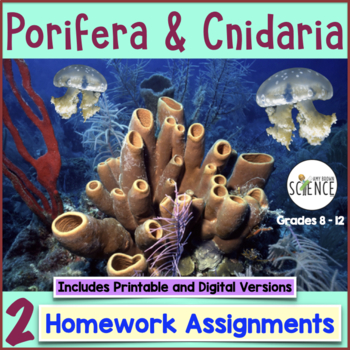Phylum Porifera and Phylum Cnidaria Homework
- Zip
- Google Apps™

Also included in
- This bundle Includes everything you need to teach a unit on Phylum Porifera and Phylum Cnidaria to your life science or biology students. Most resources are available in BOTH printable and digital formats.The bundle contains a 64-slide PowerPoint presentation, lecture notes for the teacher, a guidePrice $39.99Original Price $51.97Save $11.98
Description
Use this set of 2 homework assignments on The Phylum Porifera and Phylum Cnidaria to provide your students with quality homework assignments for your invertebrate units. Both printable and digital versions are included. This resource contains 12 student pages consisting of 131 questions. As I teach my units on these phyla, I assign a portion of these questions for homework each night. The completed homework assignments provide a thorough study guide for the unit test. You can also use a few questions during class each day to check for student understanding of the concepts being taught.
You can use these homework assignments with the Porifera/Cnidaria chapter of any biology textbook.
Both printable and digital versions of this resource are included. The student handouts can be printed or used in the paperless digital format in your Google Drive, Google Classroom, Microsoft OneDrive, or similar. This resource is perfect for traditional classroom settings, 1:1 schools, or for distance learning.
What is included in your download folder?
- Printable and Editable Phylum Porifera Homework / Study Guide - 5 Student Pages
- Printable and Editable Phylum Cnidaria Homework / Study Guide - 7 Student Pages
- Digital paperless versions (not editable) for use in Google Drive, Google Classroom, and/or Microsoft OneDrive
- 13 Page Teacher Guide and Answer Key
- Teacher Guide to Google Apps
What material is covered by each assignment?
Homework 1: Phylum Porifera
- Introduction to the Phylum Porifera.
- What is a Sponge? Definitions of Porifera, invertebrate, and sessile; embryonic development of sponges; reasons why sponges are classified as animals.
- The Body Plan of Poriferans: Asymmetry, germ layers, mesoglea, central cavity.
- External View of Sponge: Students will label the external structures of a sponge, including the osculum, spicules, buds, ostia, and base. Definitions and functions of all structures are included.
- Internal View of Sponge: Students will label a drawing that includes the osculum, ostia, central cavity, choanocytes, bud, epidermal cells, pore cells, mesoglea, and amebocytes. Definitions and functions of structures are included.
- Feeding and Digestion in Poriferans.
- Respiration, Circulation, and Excretion in Poriferans.
- Asexual Reproduction: Definitions and explanations of budding, gemmules, and regeneration; advantages and disadvantages of asexual reproduction.
- Sexual Reproduction in Poriferans: Explanation of the process, as well as the advantages of sexual reproduction; hermaphroditism.
Homework 2: Phylum Cnidaria
- Introduction to Cnidarians: List of animals belonging to Phylum Cnidaria, germ layers of cnidarians, reasons why cnidarians are more advanced than poriferans, radial symmetry, cnidocytes.
- The Cnidarian Body Plan: Comparison of medusa and polyp body plans, gastrodermis and gastrovascular cavity. Students will compare structures of the medusa and the polyp and will label the mouth, tentacles, epidermis, gastrodermis, mesoglea, and gastrovascular cavity in each.
- Feeding and Defense in Cnidarian: Cnidocytes and nematocysts, method of food-getting.
- Cnidarian Nervous System: The nerve net and how it functions.
- Cnidarian Respiration, Circulation, and Excretion.
- Classification of Cnidarians: Includes 4 classes of cnidarians – Hydrozoa, Cubozoa, Scyphozoa, and Anthozoa.
- Class Hydrozoa: Includes details of the freshwater hydra and the Portuguese man-of-war. Students will label a drawing of the hydra that includes tentacles, mouth, epidermis, gastrodermis, mesoglea, bud, base, gastrovascular cavity, testes, sperm, ovary, and egg. Asexual and sexual reproduction of hydra.
- Class Cubozoa: The box jellies.
- Class Scyphozoa: Characteristics of jellyfish. Students will complete questions on the life cycle of the jellyfish.
- Class Anthozoa: Includes details on sea anemones, the mutualistic relationship between anemones and clownfish, details about corals, and the mutualistic relationship between corals and the algae that live within them.
- Ecology of the Corals: Reasons why corals are important to marine ecosystems, the impact of human activities on coral reefs, and coral bleaching.
- Phylum Ctenophora: Comb jellies.
All answers are included in the very detailed 13 page teacher guide that is included with this resource.
Related resources include:
Porifera and Cnidaria PowerPoint and Notes Bundle
Porifera and Cnidaria Warm Ups and Bell Ringers
Phylum Porifera Jeopardy-Style Review Games - Set of 2 Games
Phylum Cnidaria Jeopardy-Style Review Games - Set of 2 Games
Phyla Porifera and Cnidaria Unit Test
Lab: Poriferans and Cnidarians
Phylum Porifera Crossword Puzzle
Phylum Cnidaria Crossword Puzzle
Invertebrate Phyla Card Sort Game
For updates about sales and new products, please follow my store:






